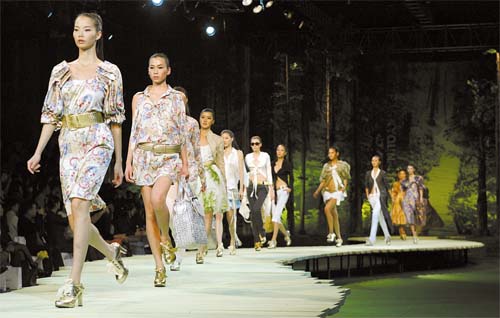Runway make fashion shows sizzle

Although the public is now more interested in fashion shows, most people are not aware of how such events are organized. Jung So-mi, 50, project manager of Seoul Collection, and Choi Mi-mi, 39, the executive secretary of the Seoul Fashion Artist Association (SFAA), sat down with the JoongAng Ilbo to explain.
Q. Most people think that the clothes shown at fashion shows are too elaborate and unsuitable for real life.
A.That is true. Outfits used for fashion shows differ from the ones that go on sale. Adjustments are made for practical reasons. These days designers try to be restrained, but fashion show outfits tend to be ahead of their time. So, some outfits may seem absurd at first, but eventually they set a new trend.
What happens to the costumes after the show?
They are valued for their rarity. They are either sold at a high price or preserved by the designers as a keepsake. As far as I know, they are never sold at bargain prices.
How are the models selected?
In the case of SFAA, we hold our own auditions. Over 700 male and female models auditioned for the show on that took place on March 17. The designers select the models they think are most suitable for their pieces. If they see someone they like, they contact the modeling agency and arrange a fitting session. On some occasions, the designers contact individual models, even if they didn’t participate in the audition. For instance, when you see celebrities on the runway, their appearance has usually been privately arranged with the designers.
How much are the models paid?
On average, there are about 15 to 20 models in a show. It takes 20 to 30 seconds to walk down the runway, and a model usually wears up to three garments. Pay checks range from 100,000 won to a million won per show. The average, I would say, is around 300,000 won. Unlike foreign models, Korean models are poorly paid. In other countries, models are paid also for the fitting sessions and rehearsals, whereas in Korea, models are only paid for the actual event.
Who are the usual audience of the show?
The press and the buyers. Foreign collections are usually filled up just with the press and buyers. For the Seoul Collection, tickets are sold to the public at 7,000 won. Designers may invite celebrities or VIP guests.
What goes on behind the stage?
About 100 staff members run around in a frenzy. There are 40 make-up artists, 20 models, and stylists to assist each model. It takes 20 to 30 seconds to change into summer/spring garments, and 2 to 3 minutes for winter/fall garments. On average, 12 hours of preparation are required for a 20-minute show.
What are the effects of fashion shows?
It does not necessarily lead to higher sales, as in other countries. In Korea designers or brands run their own stores.
However, Korean designers set the trend for the new season and introduce it to the public through fashion shows. In a way, they play a vital role in setting new trends.
Seoul Collection
The Seoul Collection is a fashion show hosted by the Seoul Fashion Designers’ Association (SFA) since 1990. In 2004, SFA changed its name to Seoul Fashion Artists Association (SFAA). Various fashion-related organizations such as New Wave Seoul (NWS), the Korean Fashion Designers Association (KFDA) and the Korean Fashion Association, began to participate in the Seoul Collection, so it now leads Korea’s fashion week. The “Fall/Winter Seoul Collection 2007/2008” took place from March 28 to Aril 5, at the Seoul Trade Exhibition and Convention (SETEC), in Daechi-dong, Seoul.
Jung So-mi
Ms. Jung has planned and directed over a hundred fashion shows, including the Seoul Collections. She also worked as a model between 1982 and 1998. In 1999, she founded “The Models,” a fashion agency for training models and fashion show planning. By traveling three months a year and attending fashion shows around the world, she is in a good position to introduce the latest fashion trends to Korea.
Choi Mi-mi
In 1988, Ms. Choi debuted as a fashion model. Since then she has appeared in numerous commercials and magazine shots. In the 90s she worked as the training director of the SBS Supermodel Contest, and was the president of SBS Beauty Academy. Currently, she is the executive secretary of SFAA.
By Ghang Seung-min JoongAng Ilbo [e-mail@joognang.co.kr]










with the Korea JoongAng Daily
To write comments, please log in to one of the accounts.
Standards Board Policy (0/250자)